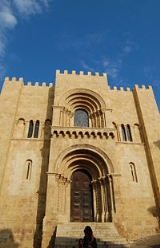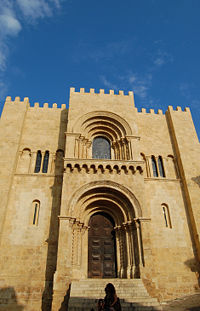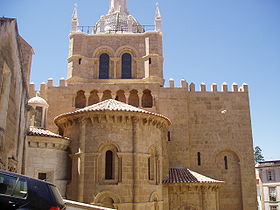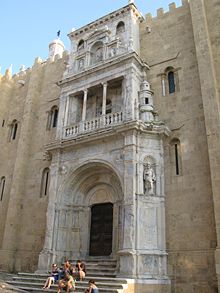
Old Cathedral of Coimbra
Encyclopedia

Romanesque architecture
Romanesque architecture is an architectural style of Medieval Europe characterised by semi-circular arches. There is no consensus for the beginning date of the Romanesque architecture, with proposals ranging from the 6th to the 10th century. It developed in the 12th century into the Gothic style,...
Roman Catholic buildings in Portugal
Portugal
Portugal , officially the Portuguese Republic is a country situated in southwestern Europe on the Iberian Peninsula. Portugal is the westernmost country of Europe, and is bordered by the Atlantic Ocean to the West and South and by Spain to the North and East. The Atlantic archipelagos of the...
. Construction of the Sé Velha began some time after the Battle of Ourique
Battle of Ourique
The Battle of Ourique saw the forces of Portuguese Prince Afonso Henriques defeat the Almoravid Moors led by Ali ibn Yusuf.-Background:...
(1139), when Count Afonso Henriques declared himself King of Portugal and chose Coimbra
Coimbra
Coimbra is a city in the municipality of Coimbra in Portugal. Although it served as the nation's capital during the High Middle Ages, it is better-known for its university, the University of Coimbra, which is one of the oldest in Europe and the oldest academic institution in the...
as capital. The first Count of Coimbra, the mozarab Sisnando Davides
Sisnando Davides
Sisnando Davides was a Mozarab nobleman and military leader of the Reconquista, born in Tentúgal, near Coimbra...
, is buried in the cathedral.
History
CoimbraCoimbra
Coimbra is a city in the municipality of Coimbra in Portugal. Although it served as the nation's capital during the High Middle Ages, it is better-known for its university, the University of Coimbra, which is one of the oldest in Europe and the oldest academic institution in the...
(the Roman
Roman Empire
The Roman Empire was the post-Republican period of the ancient Roman civilization, characterised by an autocratic form of government and large territorial holdings in Europe and around the Mediterranean....
Aeminium
Aeminium
Aeminium was the ancient name of the city of Coimbra, in Portugal.The Romans founded the civitas of Aeminium in this place at the time of Augustus, which came under the protection of nearby Conimbriga situated some 15 km away to the south....
) is the seat of a bishopric
Diocese
A diocese is the district or see under the supervision of a bishop. It is divided into parishes.An archdiocese is more significant than a diocese. An archdiocese is presided over by an archbishop whose see may have or had importance due to size or historical significance...
since the 5th century, after neighbouring Conimbriga
Conímbriga
Conímbriga is one of the largest Roman settlements in Portugal, and is classified as a National Monument. Conímbriga lies 16 km from Coimbra and less than 2 km from Condeixa-a-Nova. The site also has a museum that displays objects found by archaeologists during their excavations,...
was invaded and partially destroyed by the invading Sueves in 468. Almost nothing is known of the cathedral
Cathedral
A cathedral is a Christian church that contains the seat of a bishop...
s that preceded the Sé Velha in Coimbra. In 1139, after the Battle of Ourique
Battle of Ourique
The Battle of Ourique saw the forces of Portuguese Prince Afonso Henriques defeat the Almoravid Moors led by Ali ibn Yusuf.-Background:...
, King Afonso Henriques
Afonso I of Portugal
Afonso I or Dom Afonso Henriques , more commonly known as Afonso Henriques , nicknamed "the Conqueror" , "the Founder" or "the Great" by the Portuguese, and El-Bortukali and Ibn-Arrik by the Moors whom he fought, was the first King of Portugal...
decided to finance the building of a new cathedral, given the bad shape of its predecessor. The definitive impulse to the project was given by Bishop
Bishop
A bishop is an ordained or consecrated member of the Christian clergy who is generally entrusted with a position of authority and oversight. Within the Catholic Church, Eastern Orthodox, Oriental Orthodox Churches, in the Assyrian Church of the East, in the Independent Catholic Churches, and in the...
Miguel Salomão, who helped pay for the works. In 1185, King Sancho I
Sancho I of Portugal
Sancho I , nicknamed the Populator , second monarch of Portugal, was born on 11 November 1154 in Coimbra and died on 26 March 1212 in the same city. He was the second but only surviving legitimate son and fourth child of Afonso I of Portugal by his wife, Maud of Savoy. Sancho succeeded his father...
, second King of Portugal, was crowned in the new cathedral, indicating that the building work was in an advanced state. The basic building was finished in the first decades of the 13th century, even though the cloisters were begun only in 1218, during the reign of King Afonso II
Afonso II of Portugal
Afonso II , or Affonso , Alfonso or Alphonso or Alphonsus , nicknamed "the Fat" , third king of Portugal, was born in Coimbra on 23 April 1185 and died on 25 March 1223 in the same city. He was the second but eldest surviving son of Sancho I of Portugal by his wife, Dulce, Infanta of Aragon...
.
The project of the Romanesque
Romanesque architecture
Romanesque architecture is an architectural style of Medieval Europe characterised by semi-circular arches. There is no consensus for the beginning date of the Romanesque architecture, with proposals ranging from the 6th to the 10th century. It developed in the 12th century into the Gothic style,...
cathedral is attributed to Master Robert, a - possibly – French architect who was directing the building of Lisbon Cathedral
Lisbon Cathedral
The Patriarchal Cathedral of St. Mary Major is a Roman Catholic parish church located in Lisbon, Portugal. The oldest church in the city is the see of the Archdiocese of Lisbon. Since the beginning of the construction of the cathedral, in the year 1147, the building has been modified several...
at that time and visited Coimbra regularly. The works were supervised by Master Bernard, possibly also French, who was succeeded by Master Soeiro, an architect active in other churches around the Oporto Diocese.
In the 16th century there were many additions to the cathedral. The chapels, walls and pillars of the nave were covered with tile
Tile
A tile is a manufactured piece of hard-wearing material such as ceramic, stone, metal, or even glass. Tiles are generally used for covering roofs, floors, walls, showers, or other objects such as tabletops...
s, the monumental Porta Especiosa was built in the north side of the façade, and the southern chapel
Chapel
A chapel is a building used by Christians as a place of fellowship and worship. It may be part of a larger structure or complex, such as a church, college, hospital, palace, prison or funeral home, located on board a military or commercial ship, or it may be an entirely free-standing building,...
of the apse
Apse
In architecture, the apse is a semicircular recess covered with a hemispherical vault or semi-dome...
was rebuilt in Renaissance
Renaissance
The Renaissance was a cultural movement that spanned roughly the 14th to the 17th century, beginning in Italy in the Late Middle Ages and later spreading to the rest of Europe. The term is also used more loosely to refer to the historical era, but since the changes of the Renaissance were not...
style. The basic architecture and structure of the Romanesque building was, nevertheless, left intact. In 1772, several years after the expulsion of the Jesuits from Portugal by the Marquis of Pombal, the seat of the bishopric was transferred from the old medieval cathedral to the Mannerist
Mannerism
Mannerism is a period of European art that emerged from the later years of the Italian High Renaissance around 1520. It lasted until about 1580 in Italy, when a more Baroque style began to replace it, but Northern Mannerism continued into the early 17th century throughout much of Europe...
Jesuit church, thereafter called the New Cathedral of Coimbra
New Cathedral of Coimbra
The New Cathedral of Coimbra is the current bishopric seat of the city of Coimbra, in Portugal. The Cathedral is located near the historical University of Coimbra in the upper part of the town ....
(Sé Nova de Coimbra).

Architecture
Coimbra Cathedral is the only one of the Portuguese RomanesqueRomanesque architecture
Romanesque architecture is an architectural style of Medieval Europe characterised by semi-circular arches. There is no consensus for the beginning date of the Romanesque architecture, with proposals ranging from the 6th to the 10th century. It developed in the 12th century into the Gothic style,...
cathedrals from the Reconquista
Reconquista
The Reconquista was a period of almost 800 years in the Middle Ages during which several Christian kingdoms succeeded in retaking the Muslim-controlled areas of the Iberian Peninsula broadly known as Al-Andalus...
times to have survived relatively intact up to the present. The cathedrals of Oporto, Braga
Braga
Braga , a city in the Braga Municipality in northwestern Portugal, is the capital of the Braga District, the oldest archdiocese and the third major city of the country. Braga is the oldest Portuguese city and one of the oldest Christian cities in the World...
, Lisbon
Lisbon Cathedral
The Patriarchal Cathedral of St. Mary Major is a Roman Catholic parish church located in Lisbon, Portugal. The oldest church in the city is the see of the Archdiocese of Lisbon. Since the beginning of the construction of the cathedral, in the year 1147, the building has been modified several...
and others have been extensively remodelled later.
Exterior
From the outside, Coimbra's old cathedral looks like a small fortress, with its high, crenellated walls harbouring few, narrow windows. This menacing appearance is explained by the belligerent times in which it was built. There is a tower-like structure in the middle of the western façade with a portal and a similar-looking upper window. Both portal and window are heavily decorated with Romanesque motifs of ArabicIslamic art
Islamic art encompasses the visual arts produced from the 7th century onwards by people who lived within the territory that was inhabited by or ruled by culturally Islamic populations...
and Pre-romanesque influences. The façade is reinforced by thick buttress
Buttress
A buttress is an architectural structure built against or projecting from a wall which serves to support or reinforce the wall...
es at the corners that compensate for the angle of the terrain (the cathedral was built on the slope of a hill).
The north façade has a remarkable, although eroded, Renaissance
Renaissance
The Renaissance was a cultural movement that spanned roughly the 14th to the 17th century, beginning in Italy in the Late Middle Ages and later spreading to the rest of Europe. The term is also used more loosely to refer to the historical era, but since the changes of the Renaissance were not...
-style portal called the Porta Especiosa. The three-storey portal was built in the 1530’s by French sculptor João de Ruão (Jean of Rouen). From the east side one can see the semicircular apse
Apse
In architecture, the apse is a semicircular recess covered with a hemispherical vault or semi-dome...
with its three radiating chapels, the main and the northern chapels are still Romanesque while the southern one has been rebuilt in Renaissance times. Over the transept
Transept
For the periodical go to The Transept.A transept is a transverse section, of any building, which lies across the main body of the building. In Christian churches, a transept is an area set crosswise to the nave in a cruciform building in Romanesque and Gothic Christian church architecture...
there is a Romanesque lantern-tower
Dome
A dome is a structural element of architecture that resembles the hollow upper half of a sphere. Dome structures made of various materials have a long architectural lineage extending into prehistory....
with some Baroque
Baroque
The Baroque is a period and the style that used exaggerated motion and clear, easily interpreted detail to produce drama, tension, exuberance, and grandeur in sculpture, painting, literature, dance, and music...
details.

Interior
The interior of the cathedral has a naveNave
In Romanesque and Gothic Christian abbey, cathedral basilica and church architecture, the nave is the central approach to the high altar, the main body of the church. "Nave" was probably suggested by the keel shape of its vaulting...
with two aisle
Aisle
An aisle is, in general, a space for walking with rows of seats on both sides or with rows of seats on one side and a wall on the other...
s, a small transept, and an eastern apse
Apse
In architecture, the apse is a semicircular recess covered with a hemispherical vault or semi-dome...
with three chapels. The nave is covered by barrel vault
Barrel vault
A barrel vault, also known as a tunnel vault or a wagon vault, is an architectural element formed by the extrusion of a single curve along a given distance. The curves are typically circular in shape, lending a semi-cylindrical appearance to the total design...
ing and the lateral aisles by groin vault
Groin vault
A groin vault or groined vault is produced by the intersection at right angles of two barrel vaults. The word groin refers to the edge between the intersecting vaults; cf. ribbed vault. Sometimes the arches of groin vaults are pointed instead of round...
s. The nave has an upper storey, a spacious triforium
Triforium
A triforium is a shallow arched gallery within the thickness of inner wall, which stands above the nave of a church or cathedral. It may occur at the level of the clerestory windows, or it may be located as a separate level below the clerestory. It may itself have an outer wall of glass rather than...
(arched gallery), that could accommodate more mass attendants in the tribunes if needed. All columns of the interior have decorated capitals
Capital (architecture)
In architecture the capital forms the topmost member of a column . It mediates between the column and the load thrusting down upon it, broadening the area of the column's supporting surface...
, mainly with vegetable motifs, but also with animals and geometric patterns. The windows of the lantern-tower and the big window in the west facade are the main sources of natural light of the cathedral.
The cloister
Cloister
A cloister is a rectangular open space surrounded by covered walks or open galleries, with open arcades on the inner side, running along the walls of buildings and forming a quadrangle or garth...
, built during the reign of Afonso II (early 13th century), is a work of the transition between Romanesque and Gothic
Gothic architecture
Gothic architecture is a style of architecture that flourished during the high and late medieval period. It evolved from Romanesque architecture and was succeeded by Renaissance architecture....
. Each of the Gothic pointed arches that face the courtyard encompass two twin round arches in Romanesque style.
Capitals
The most remarkable aspect of the Romanesque decoration of the Old Coimbra Cathedral is the large number of sculptured capitalsCapital (architecture)
In architecture the capital forms the topmost member of a column . It mediates between the column and the load thrusting down upon it, broadening the area of the column's supporting surface...
(around 380), which turns it into one of the most important ensembles of Romanesque sculpture in Portugal. The main motifs are vegetal and geometric and reveal Arab and pre-romanesque influences, but there are also pairs of quadrupeds (including centaurs) or birds facing each other. There are virtually no human representations, and no Biblical scenes. The absence of sculptured human figures may be because many of the artists that worked in the Cathedral were mozarab
Mozarab
The Mozarabs were Iberian Christians who lived under Arab Islamic rule in Al-Andalus. Their descendants remained unconverted to Islam, but did however adopt elements of Arabic language and culture...
ic, i.e. Christians who lived in Arab territories and that had settled in Coimbra in the 12th century. These artists were perhaps not used to human representations, which are forbidden in Islam
Islam
Islam . The most common are and . : Arabic pronunciation varies regionally. The first vowel ranges from ~~. The second vowel ranges from ~~~...
.
Tombs
From the GothicGothic art
Gothic art was a Medieval art movement that developed in France out of Romanesque art in the mid-12th century, led by the concurrent development of Gothic architecture. It spread to all of Western Europe, but took over art more completely north of the Alps, never quite effacing more classical...
era (13th-14th centuries) there are several tombs with laying statues along the lateral aisles, some very much eroded. The most remarkable is that of Lady Vataça Lascaris
Vataça Lascaris
Lady Vataça Lascaris , also referred as Vatatsa Lascaris, Vataça of Ventimiglia, Dona Betaça, Betaça de Grécia, Vatatsa or Vetacia was an Italian princess of Byzantine Greek origin....
(or Betaça), a Byzantine that came to Portugal in the beginning of the 14th century together with Elizabeth of Aragon, who was to marry King Dinis I. Her tomb carries the symbol of the Byzantine Empire
Byzantine Empire
The Byzantine Empire was the Eastern Roman Empire during the periods of Late Antiquity and the Middle Ages, centred on the capital of Constantinople. Known simply as the Roman Empire or Romania to its inhabitants and neighbours, the Empire was the direct continuation of the Ancient Roman State...
: a two-headed eagle.

16th century
At the turn of the 15th to the 16th century, bishop Jorge de Almeida sponsored a major decorative campaign. The columns and walls of the aisles were covered with tileTile
A tile is a manufactured piece of hard-wearing material such as ceramic, stone, metal, or even glass. Tiles are generally used for covering roofs, floors, walls, showers, or other objects such as tabletops...
s from Seville
Seville
Seville is the artistic, historic, cultural, and financial capital of southern Spain. It is the capital of the autonomous community of Andalusia and of the province of Seville. It is situated on the plain of the River Guadalquivir, with an average elevation of above sea level...
, which bear multi-coloured geometric motifs reminiscent of Arab
Arabesque
The arabesque is a form of artistic decoration consisting of "surface decorations based on rhythmic linear patterns of scrolling and interlacing foliage, tendrils" or plain lines, often combined with other elements...
art. Most have been removed but many remain, specially in the wall to the left of the entrance of the Cathedral, as well as in many chapels and funerary monuments. Another important addition was the huge wooden retable
Retable
A retable is a framed altarpiece, raised slightly above the back of the altar or communion table, on which are placed the cross, ceremonial candlesticks and other ornaments....
of the main chapel, carved between 1498 and 1502 by Flemish
Flemish people
The Flemings or Flemish are the Dutch-speaking inhabitants of Belgium, where they are mostly found in the northern region of Flanders. They are one of two principal cultural-linguistic groups in Belgium, the other being the French-speaking Walloons...
artists Olivier de Gand and Jean d’Ypres. The retable, in Flamboyant Gothic style, illustrates the history of Mary and Christ and occupies the whole space of the Romanesque main chapel. It is the best of its kind in the country. The altar
Altar
An altar is any structure upon which offerings such as sacrifices are made for religious purposes. Altars are usually found at shrines, and they can be located in temples, churches and other places of worship...
is supported by an altar table in Romanesque style.
The northern chapel (chapel of Saint Peter) has a Renaissance
Renaissance
The Renaissance was a cultural movement that spanned roughly the 14th to the 17th century, beginning in Italy in the Late Middle Ages and later spreading to the rest of Europe. The term is also used more loosely to refer to the historical era, but since the changes of the Renaissance were not...
altar by French
France
The French Republic , The French Republic , The French Republic , (commonly known as France , is a unitary semi-presidential republic in Western Europe with several overseas territories and islands located on other continents and in the Indian, Pacific, and Atlantic oceans. Metropolitan France...
sculptor Nicolau Chanterene
Nicolau Chanterene
Nicolau Chanterene was a French sculptor and architect who worked mainly in Portugal and Spain....
(early 16th century). The southern chapel of the apse was totally rebuilt in high Renaissance style and contains a magnificent retable featuring Jesus and the Apostles. The altar was finished around 1566 and is the work of João de Ruão (Jean of Rouen). In the 1530’s, the same artist had built the Porta Especiosa in the North façade.
The transept has a nice baptismal font
Baptismal font
A baptismal font is an article of church furniture or a fixture used for the baptism of children and adults.-Aspersion and affusion fonts:...
in Gothic-Renaissance style (1520-1540), from the church of Saint John of Almedina (São João de Almedina). The original Manueline
Manueline
The Manueline, or Portuguese late Gothic, is the sumptuous, composite Portuguese style of architectural ornamentation of the first decades of the 16th century, incorporating maritime elements and representations of the discoveries brought from the voyages of Vasco da Gama and Pedro Álvares Cabral...
baptismal font from Coimbra Cathedral is now in the New Cathedral of Coimbra
New Cathedral of Coimbra
The New Cathedral of Coimbra is the current bishopric seat of the city of Coimbra, in Portugal. The Cathedral is located near the historical University of Coimbra in the upper part of the town ....
(the former Jesuit church of the city).

